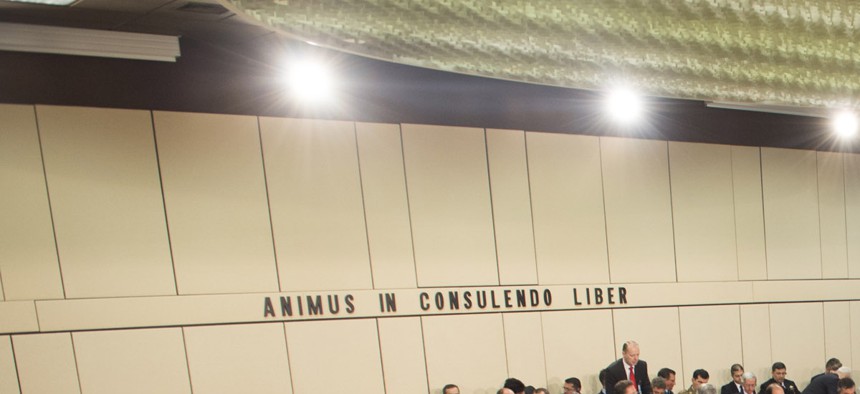
NATO defense ministers including Defense Secretary Chuck Hagel met in Brussels, Oct. 22, 2013. DOD photo by U.S. Marine Corps Sgt. Aaron Hostutler
A Missed Chance for NATO’s Cybersecurity Future
On the back of NATO’s defense ministerial, member-states still need to address the alliance’s major cybersecurity shortfalls – and there are plenty. By Daniel Pitcairn
After a meeting of NATO defense ministers in Brussels this week, questions loom large for the alliance’s cyber strategy. Defense Secretary Chuck Hagel said the ministers “agreed that the alliance must do more to deal with cyber threats,” but they did not take the opportunity to elaborate on its cybersecurity role and potential responses in case of cyber warfare.
In the aftermath of major cyberattacks on Estonia in 2007 by ‘patriotic’ hackers in Russia, NATO moved quickly to update its then-primitive cyber defenses. Within a year, NATO countries laid some groundwork for a centralized defense of NATO networks. The alliance created Rapid Reaction Teams to aid member-states under cyberattack and established a state-of-the-art cyber research center. At the 2010 and 2012 summits in Lisbon and Chicago, the alliance developed and affirmed a defensive cyber strategy. However, more than six years after the Estonia attacks, NATO is still behind the curve in two crucial ways: cyber warfare is not incorporated into its strategic doctrine and member-states' individual cyber weaknesses are becoming a major liability for the entire alliance.
The outstanding question for NATO’s cyber strategy is whether or not its famous Article 5 -- the statute asserting, “an armed attack against one or more… shall be considered an attack against them all” -- should apply to cyberattacks. Those allies and scholars who oppose extending the collective defense trigger argue that cyber deterrence is nearly impossible because cyberspace provides anonymity to adversaries. However, extending the application of Article 5 to cyberattacks that meet a certain threshold of severity might actually give NATO more flexible response options. In the case of a severe cyberattack, the alliance would not be required to act militarily -- it would simply have the authority to do so to the fullest extent. Just as the U.S. has asserted that it “will respond to hostile acts in cyberspace just as [it] would to any other threat,” so should NATO be prepared to use its full capabilities to counter cyberattacks.
The adoption of Article 5 also could help stabilize the growing cyber arms race. The lack of established conventions and norms governing conflict in cyberspace has generated uncertainty that translates into a lingering security dilemma. By extending Article 5 to the cyber domain, NATO would link military action in cyberspace to international law -- the Law of Armed Conflict -- the set of governing rules for inter-state conflict agreed to by the international community.
At the national level, some member-states do not yet have robust cybersecurity strategies of their own. While the U.S. and U.K. have given their defense agencies a primary role in developing cybersecurity, several allies including Germany, the Czech Republic, Slovakia and Romania have given leading roles to their interior, finance or communications ministries.
Hagel said that NATO’s cyber defense capability “is on track to achieve full operational capabilities next week,” but the integrity of allied information sharing is only as good as its member-states’ networks. Due to national sovereignty concerns of member-states, NATO decided it would not be responsible for national network security. This presents a particular problem for countries like the U.S., which have a great deal to lose through vulnerable networks of weaker member-states. The security of these networks is essential for the safeguarding of critical information on key U.S. military assets and strategies. Of greatest concern is the information allies are permitted to receive regarding U.S. nuclear weapons. The ATOMAL Agreement of 1965 allows NATO allies to receive confidential information on U.S. nuclear weapons capabilities and strategy in order to ensure the alliance’s effective collective military capacity. New and aspiring members of NATO may not be prepared to defend their networks from the growth in cyber attacks they will face when they become privy to critical U.S. national security information.
At a time when NATO’s future is unclear, the alliance cannot afford to have cybersecurity concerns jeopardizing working relationships between allies. NATO should move beyond statements and prioritize setting minimal security requirements for member-states’ networks. If the alliance is to cement its role as a reliable provider of stability and security for the transatlantic community in the 21st century, it must tackle the most fundamental cyber issues head on.
Daniel Pitcairn is a research fellow with Government Business Council.
